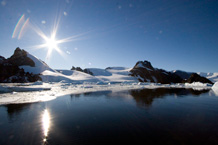Exploring the Poles: Above, in and below the snow
With Ally Lewis, Kelly Redeker and David Pearce
 Alexander Island in Antarctica, courtesy James Chong
Alexander Island in Antarctica, courtesy James Chong
- Thursday 20 June 2013, 5.00PM
- Free admission
Booking required, see below for tickets - Ron Cooke Hub, University of York (See locations page)
Event details
The Polar regions are a rich resource for science. Join three scientists, from York and the British Antarctic Survey, whose research takes place above, in and below the snow, to explore climate change, microbes and life in Antarctic sub-glacial lakes.
Chemistry in cold climates
Ally Lewis
The atmosphere at the poles is highly sensitive to pollution – stratospheric ozone depletion and climate warming are all induced by air pollutants in polar regions. Polar regions experience extremes in air pollution chemistry, driven by sunlight, low temperatures and ice and snow covered surfaces. Whilst in the upper polar atmosphere, aircraft and satellites provide a means to detect chemical change, in the atmosphere’s lowest layers, there is no alternative but to put people and instruments on the ground. This talk will describe some of the science and technology of polar atmospheric chemistry, and the practical challenges of performing chemistry in the cold.
The complex chemistry/biology of newly fallen Antarctic snow
Kelly Redeker
Antarctic and Greenland ice cores provide one of the most depended upon proxies for past climate and atmospheric composition. Recent research has shown however that bacteria can survive for thousands of years and remain biologically active, even under extreme conditions. We examined the production and consumption of low concentration trace gases in newly fallen Antarctic snow as a tool to determine biological activity.
The exploration of Antarctic subglacial lakes
David Pearce
Since the first descriptions of Antarctic subglacial lakes there has been a growing interest and awareness of the possibility that life will exist and potentially thrive in these unique and little known environments. The unusual combination of selection pressures and isolation from the rest of the biosphere, might have lead to novel adaptations and physiology not seen before, or indeed to the potential discovery of relic populations that may have become extinct elsewhere. As a result of significant and growing interest, three ambitious projects aimed to enter and retrieve samples from deep continental Antarctic subglacial lakes over the 2012/2013 Antarctic field season. Here we discuss what new knowledge might be gained from their exploration and why we go to such lengths to understand them.

